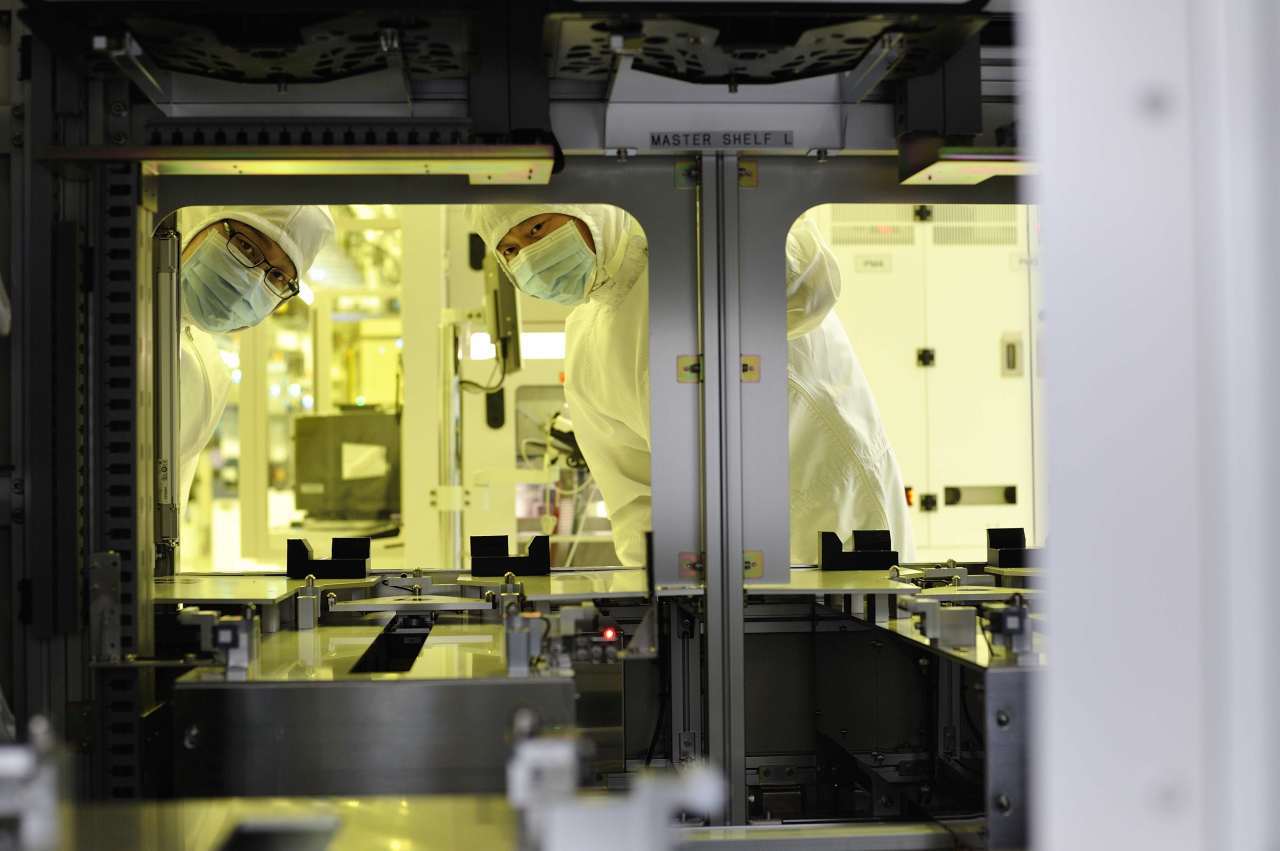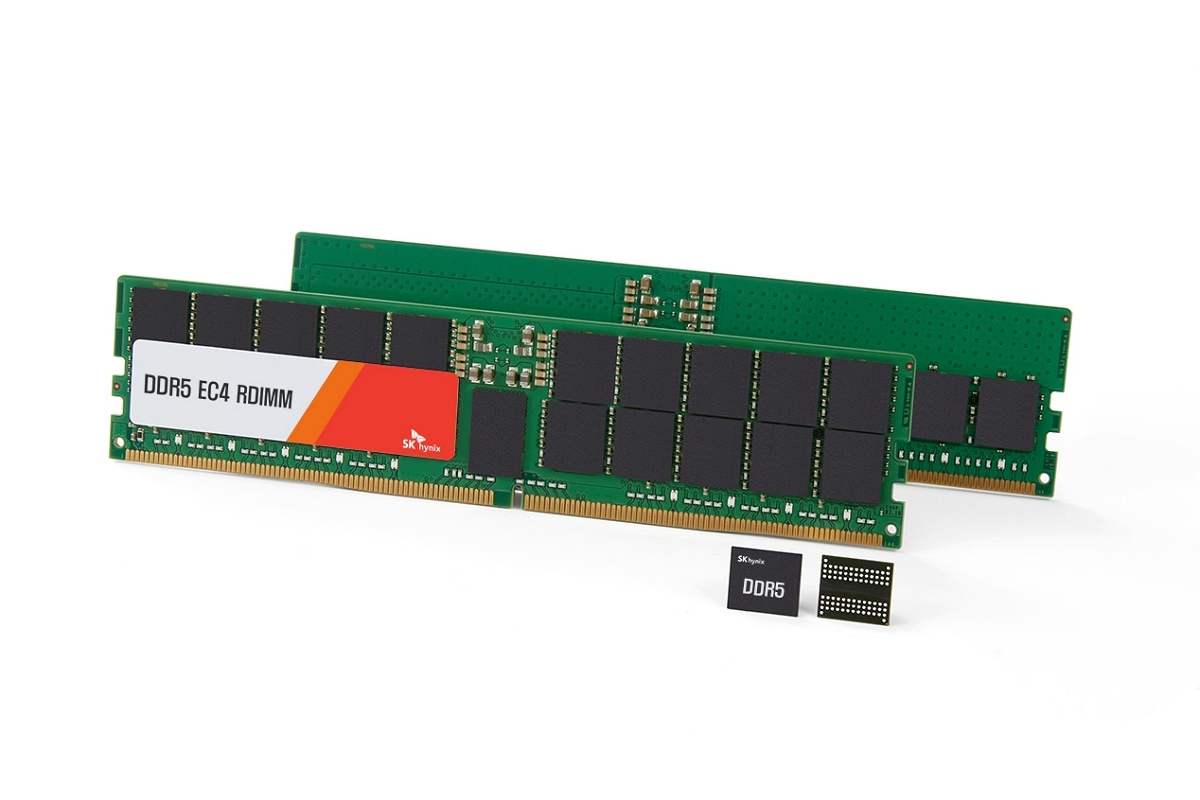Race for next-gen DRAM chips heats up with SK hynix’s new release
New memory chip features industry’s largest density tailored to data centers, servers
By Son Ji-hyoungPublished : Dec. 15, 2021 - 15:24

The race for next-generation DDR5 memory chips is intensifying, with SK hynix unloading its latest chip featuring an enhanced density enough to boost performance of cloud data centers and potentially of high-performance servers.
SK hynix said Wednesday it has shipped samples of 24-gigabit DDR5 dynamic random access memory chips, touting its technology leadership in commercializing a single DRAM chip that has the largest density in the industry. DDR5, or double data rate 5, refers to a newest iteration that offers faster data speed and consumes less energy, compared to the widely-commercialized DDR4.
The new product, born under the 1-alpha nanometer technology and extreme ultraviolet lithography process, will be offered with increased speed by up to 33 percent from the 16-gigabit DDR5 DRAMs. The production efficiency will be enhanced, reducing power consumption by 25 percent compared to existing products in pursuit of a more eco-friendly production process, according to the company. DDR5 DRAM offerings have so far come in densities of 8-gigabit or 16-gigabit.
The initial offerings on 24-gigabit DDR5 DRAMs will comprise its 48-gigabyte and 96-gigabyte DRAM modules, which, in conjunction with integrated circuit chips, could power cloud data centers and high-performance servers for big data processing, as well as realizing metaverse applications, the company said.
“In line with the release of 24-gigabit DDR5, SK hynix is closely engaging with a number of customers that provides cloud services. We will continue to strengthen our leadership in growing DDR5 market by introducing advanced technologies and developing products with ESG-awareness,” Noh Jong-won, president and chief marketing officer at SK hynix, said in a statement.
This comes as US tech giant Intel is preparing to launch the next-generational Sapphire Rapids processors that are compatible with DDR5 memory chips as early as in the second half of 2022. Intel’s latest server processor, Ice Lake, launched in April, supports its predecessor DDR4 chips.
The news is a testament of the partnership between SK hynix and Intel to ”deliver a 24Gb solution to address needs of our mutual customers“ and ”help customers boost performance of memory capacity bound workloads,“ said Carolyn Duran, vice president of memory and IO technologies in Intel’s Data Center and AI Group.
SK hynix said Wednesday it has shipped samples of 24-gigabit DDR5 dynamic random access memory chips, touting its technology leadership in commercializing a single DRAM chip that has the largest density in the industry. DDR5, or double data rate 5, refers to a newest iteration that offers faster data speed and consumes less energy, compared to the widely-commercialized DDR4.
The new product, born under the 1-alpha nanometer technology and extreme ultraviolet lithography process, will be offered with increased speed by up to 33 percent from the 16-gigabit DDR5 DRAMs. The production efficiency will be enhanced, reducing power consumption by 25 percent compared to existing products in pursuit of a more eco-friendly production process, according to the company. DDR5 DRAM offerings have so far come in densities of 8-gigabit or 16-gigabit.
The initial offerings on 24-gigabit DDR5 DRAMs will comprise its 48-gigabyte and 96-gigabyte DRAM modules, which, in conjunction with integrated circuit chips, could power cloud data centers and high-performance servers for big data processing, as well as realizing metaverse applications, the company said.
“In line with the release of 24-gigabit DDR5, SK hynix is closely engaging with a number of customers that provides cloud services. We will continue to strengthen our leadership in growing DDR5 market by introducing advanced technologies and developing products with ESG-awareness,” Noh Jong-won, president and chief marketing officer at SK hynix, said in a statement.
This comes as US tech giant Intel is preparing to launch the next-generational Sapphire Rapids processors that are compatible with DDR5 memory chips as early as in the second half of 2022. Intel’s latest server processor, Ice Lake, launched in April, supports its predecessor DDR4 chips.
The news is a testament of the partnership between SK hynix and Intel to ”deliver a 24Gb solution to address needs of our mutual customers“ and ”help customers boost performance of memory capacity bound workloads,“ said Carolyn Duran, vice president of memory and IO technologies in Intel’s Data Center and AI Group.

SK hynix, which supplies DRAM chips, as well as flash memory chips and complementary metal oxide semiconductor image sensors to its clients, has sought to bring its next-generation DRAM technologies to the mainstream, amid a sustained memory chip price decline.
In October 2020, SK hynix said it has completed tests and verifications of DDR5 DRAM modules’ functions and compatibility with IC chips and central processing units, two years after announcing the development of world’s first 16-gigabit DDR5 DRAM in November 2018.
Following suit, SK hynix’s memory chip rival Samsung Electronics unveiled the world’s first High-K Metal Gate-based DDR5 modules in March.
Such technological advancements have apparently laid the groundwork for Intel’s rollout of the 12th-generational Alder Lake processors for desktop personal computers in November that both support DDR5 and its predecessor DDR4 memory chips. Its rival Advanced Micro Devices is also reportedly looking to launch processors that support DDR5 chips by next year.
A recent report by Shinhan Investment forecast the DDR5 chip penetration rate to stand at 3 percent as of the first quarter of 2022, while the constantly rising penetration of chips could lead to a surge in average selling price of memory chips by around 5 percent.
Meanwhile, the price for DRAM chips, regardless of their generations, is projected to continue to fall.
According to Taiwan-based semiconductor industry tracker TrendForce, DDR4 DRAM chips for personal computers will undergo on-quarter declines of 5-10 percent in average sales price, while DDR5 chips will experience a 3-8 percent fall, in the first quarter of 2022. TrendForce added that DDR5 DRAM chips will not noticeably impact the overall PC DRAM unit price, as its penetration rate is still relatively low.
A spokesperson of SK hynix said it would start mass-producing 24-gigabit DDR5 DRAMs next year.
In October 2020, SK hynix said it has completed tests and verifications of DDR5 DRAM modules’ functions and compatibility with IC chips and central processing units, two years after announcing the development of world’s first 16-gigabit DDR5 DRAM in November 2018.
Following suit, SK hynix’s memory chip rival Samsung Electronics unveiled the world’s first High-K Metal Gate-based DDR5 modules in March.
Such technological advancements have apparently laid the groundwork for Intel’s rollout of the 12th-generational Alder Lake processors for desktop personal computers in November that both support DDR5 and its predecessor DDR4 memory chips. Its rival Advanced Micro Devices is also reportedly looking to launch processors that support DDR5 chips by next year.
A recent report by Shinhan Investment forecast the DDR5 chip penetration rate to stand at 3 percent as of the first quarter of 2022, while the constantly rising penetration of chips could lead to a surge in average selling price of memory chips by around 5 percent.
Meanwhile, the price for DRAM chips, regardless of their generations, is projected to continue to fall.
According to Taiwan-based semiconductor industry tracker TrendForce, DDR4 DRAM chips for personal computers will undergo on-quarter declines of 5-10 percent in average sales price, while DDR5 chips will experience a 3-8 percent fall, in the first quarter of 2022. TrendForce added that DDR5 DRAM chips will not noticeably impact the overall PC DRAM unit price, as its penetration rate is still relatively low.
A spokesperson of SK hynix said it would start mass-producing 24-gigabit DDR5 DRAMs next year.



















![[Today’s K-pop] BTS pop-up event to come to Seoul](http://res.heraldm.com/phpwas/restmb_idxmake.php?idx=642&simg=/content/image/2024/04/17/20240417050734_0.jpg&u=)